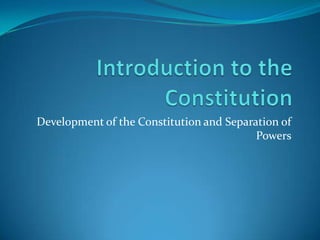
Chapt 2
- 1. Introduction to the Constitution Development of the Constitution and Separation of Powers
- 2. Focus What collective action problems did the framers face? How to aggregate preferences? Is the U.S. democratic? What sort of “tyranny did the framers fear? What did the framers get right? What did they get wrong?
- 3. Principles and Agents Principles: individuals who possess authority to make decisions Agents: someone who implements the decisions of a principle
- 4. P-A Relationships and the Founding English Monarchy and colonial governments Articles of Confederation- States and the National Government Delegates of the Constitutional Convention and the states U.S. Constitution- people and the government
- 5. Flaws of the Articles of Confederation Gridlock Bankruptcy Economic troubles Unresolved conflicts Executive problems
- 6. Shay’s Rebelliona case study of the problems with AoC Imagine today… soldiers from Iraq coming home to foreclosed on homes… Daniel Shay and friends were soldier/farmers Took over armory Blockaded town hall Prevent banks from filing foreclosure papers The effect on the “framers” Worried about “tyranny of majority” Worried about excessive democracy Did not trust average citizen to be a rational actor, that is to put long-term interest before short term.
- 7. THE UNITED STATES CONSTITUTION: MISTAKEN POPULAR CONCEPTIONS Myth The Constitution was a popular document and there was widespread consensus on its principles and the need for its ratification. Reality The Constitution was the result of many conflicts and compromises, and the fight over its ratification was an intense ideological and political battle between Federalists and Anti-Federalists.
- 8. THE UNITED STATES CONSTITUTION: MISTAKEN POPULAR CONCEPTIONS Myth The Constitution was a democratic document. Reality Much of the document aimed at curbing “excessive” democracy. Rather than a democratic document, the Constitution is more properly understood as a republican one.
- 9. Federalists v Anti-federalists Supported the new Constitution Did not support the Bill of Rights idea Favored filters for “common citizens” and elite rule Elites, property owners, merchants… upper class Did not approve of the new Constitution Required the Bill of Rights Favored states’ rights, local control, and strong protections of liberties Small farmers, shopkeepers, debtors… common folks
- 10. Four Key Principles of the U.S. Constitution Representative democracy or a republican form of government Separation of Powers with Checks and Balances Federalism Strong Respect for Civil Rights and Civil Liberties
- 11. FederalistPapers Reasons why the new constitution should be supported Federalist #10 and # 51
- 12. Factions People rally around short term interests rather than acting for long-term benefit Cause: “OUR PROPENSITY TO VEX AND OPPRESS EACH OTHER.” “a number of citizens, whether amounting to a majority or minority of the whole, who are united and actuated by some common impulse of passion, or of interest, adverse to the rights of other citizens, or to the permanent and aggregate interests of the community.”
- 13. Solving for Factions Minority factions Majority rules Majority factions Representative democracy Competitive elections which allow for virtuous to be elected Large geographic districts
- 14. Preventing Factions by Districts Legislative Districts Senate Districts Electoral College
- 15. THE UNITED STATES CONSTITUTION: MISTAKEN POPULAR CONCEPTIONS Myth As with any Constitutional government, the U.S. Constitution limited government power. Reality Although there are many limitations on the government in the Constitution, its ratification actually represented a “power grab” that increased the strength of the central government.
- 16. Representation: A Key Principle-Agent Debate Virginia Plan New Jersey Plan Great Compromise
- 17. Federalist #51 Why 3 branches? Why separation of powers? Why checks and balances
- 18. Federalist #51 “Ambition must be made to counteract ambition. The interest of the man must be connected with the constitutional rights of the place. It may be a reflection on human nature that such devices should be necessary to control the abuses of government. But what is government itself but the greatest of all reflections on human nature? If men were angels, no government would be necessary. If angels were to govern men, neither external nor internal controls on government would be necessary.” --James Madison (Publius), Federalist #51
- 19. Separation of Powers The division of powers among several institutions that must cooperate in decision or policy-making The allocation of constitutional authority to each of the three branches of government With different responsibilities Different powers Different constituencies, which makes them accountable to different groups of people Different terms of service
- 22. Increasing powers of the president
- 24. Fig. 2.2